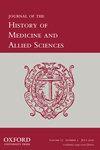大流行病形式
IF 0.4
3区 哲学
Q4 HEALTH CARE SCIENCES & SERVICES
Journal of the History of Medicine and Allied Sciences
Pub Date : 2024-05-03
DOI:10.1093/jhmas/jrae003
引用次数: 0
摘要
叙事结构虽然肉眼不可见,却能引导我们理解大流行病。就像曲线和图表一样,我们可以绘制它们,识别它们的模式和组织原则。这些结构与病毒复制和变异的节奏一样,影响着我们对社会和生物事件的理解。它们不仅使自身有序化,也使社会和健康结果有序化。本文利用叙事的精确性,超越查尔斯-罗森伯格(Charles Rosenberg)极具影响力的戏剧模式,发展出新的流行病形式,从单个断句到多部分系列:弧线,一种序列形式。循环,一种重复形式。接续,一种拉长形式。Caesura, 一种断句形式。它研究了这些形式的潜力和局限性,它们是如何交叉、碰撞和矛盾的,以及对这些相互作用的分析如何有助于加深对流行病、其影响以及定义其结构的不同观点的理解。在此过程中,该书展示了文学方法如何为大流行病史学提供概念框架,以及跨学科的医学人文分析如何在健康、文化和社会的交叉点上产生新的理解。本文章由计算机程序翻译,如有差异,请以英文原文为准。
Pandemic Forms
Narrative structures, though invisible to the naked eye, guide our understanding of pandemics. Like curves and graphs, we can plot them, identify their patterns and organizing principles. These structures act upon our understanding of social and biological events just as much as the rhythms of viral replication and mutation. They order not only themselves but also social and health outcomes. This essay uses narrative precision to expand beyond Charles Rosenberg’s influential dramaturgic model and develops new pandemic forms, scaled from the level of an individual line break to the multi-part series: Arc, a form of sequence. Cycle, a form of repetition. Sequel, a form of elongation. Caesura, a form of break. It investigates the potentialities and limitations of these forms, how they intersect, collide, and contradict, and how analysis of these interactions contributes to a deeper understanding of pandemics, their effects, and the diverse perspectives defining their structures. In doing so, it prototypes how literary methods offer conceptual frameworks for pandemic historiography and how a transdisciplinary, medical humanities analysis produces novel understandings at the intersection of health, culture, and society.
求助全文
通过发布文献求助,成功后即可免费获取论文全文。
去求助
来源期刊

Journal of the History of Medicine and Allied Sciences
管理科学-科学史与科学哲学
CiteScore
1.00
自引率
0.00%
发文量
40
审稿时长
>12 weeks
期刊介绍:
Started in 1946, the Journal of the History of Medicine and Allied Sciences is internationally recognized as one of the top publications in its field. The journal''s coverage is broad, publishing the latest original research on the written beginnings of medicine in all its aspects. When possible and appropriate, it focuses on what practitioners of the healing arts did or taught, and how their peers, as well as patients, received and interpreted their efforts.
Subscribers include clinicians and hospital libraries, as well as academic and public historians.
 求助内容:
求助内容: 应助结果提醒方式:
应助结果提醒方式:


